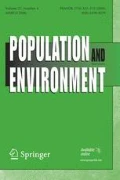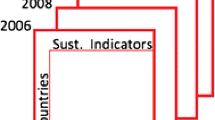Abstract
In this article a macro-oriented conceptual framework of the conditions necessary for the advancement of sustainability within an economy and society is formulated and analysed. The theoretical framework presented is a set of logical identities, which define relationships between the total environmental stress (TES) and the basic indicators of economic, technological and social development. The framework, called the Total Environmental Stress Approach, provides necessary but not sufficient conditions for advancing sustainability. Scenario alternatives utilizing the TES approach with data from Finland are presented to evaluate the theoretical framework.
Similar content being viewed by others
References
Commoner, B. (1971). The closing circle: nature, man, and technology. In M. A. Cahn & R. O'Brien, (Eds.), Thinking About The Environment (pp. 161–166). Armonk, NY: M. E. Sharpe, Inc.
Daly, H., & Cobb, J. B. (1989). For the Common Good. Redirecting the economy towards community, the environment and a sustainable future. London: Green Print.
Ehrlich, P., & Ehrlich, A. (1970). Population, Resources and Environment. San Francisco: W. H. Freeman.
Ekins, P. (1991). The sustainable consumer society: a contradiction in terms? International Environmental Affairs, 3(4), 243–258.
Ekins, P. (1996). “Limits to growth” and “sustainable development”: grappling with ecological realities. In K.P. Jameson & C.K. Wilber (Eds.), The political economy of development and underdevelopment (pp. 53–69). New York: McGraw-Hill.
FEANI (1972). Environmental Committee of FEANI, Meeting on 20 August 1972. Meeting memorandum by M. Gilles, August 1972.
Femia, A., Hinterberger, F., & Luks, F. (1999a). Ecological economic policy for sustainable development. Potentials and domains of intervention for de-linking approaches. SERI Working Paper No. 1. Vienna: Sustainable Europe Research Institute.
Femia, A., Hinterberger, F., & Renn, S. (1999b). Economic growth with less material input? De-composing the empirical trend of de-linking. Paper prepared for the Symposium “Energetic and Material Metabolism” at the Conference on “Nature, Society and History. Long Term Dynamics of Social Metabolism,” Vienna, September 30–October 2, 1999.
Hoffre´n, J. (1999a). Material flow accounting as a measure of the total consumption of natural resources. The Finnish Environment 287. Helsinki: Ministry of the Environment, Eurostat.
Hoffre´n, J. (1999b). Economy as generator of wellbeing and environmental damage—measuring the Finnish eco-efficiency. Helsinki: Statistics Finland, Research Reports 226.
Hoffre´n, J., Luukkanen, J., & Kaivo-oja, J. (2001). Decomposition analysis of Finnish material flows: 1960–1996. Journal of Industrial Ecology, 4(4), 91–112.
Kaivo-oja, J., Luukkanen, J., & Malaska, P. (2001). Advanced sustainability analysis. In M.K. Tolba (Ed.) Our fragile world. Challenges and opportunities for sustainable development. Encyclopedia of life support systems and sustainable development. Vol 2. Oxford: EOLSS Publishers Co. Ltd.
Malaska, P. (1971). Future prospects of technical man. Helsinki: Insinöörien kustannus.
Malaska, P. (1994). Progress, nature and technology in late-modern transition. Futures, 26(5), 529–542.
Malaska, P., Kaivo-oja, J., & Luukkanen, J. (1999). Sustainability and economic growth: A theoretical framework and empirical demonstrations. FUTU-publication 4/99, Turku: Finland Futures Research Centre. Turku School of Economics and Business Administration.
Spangenberg, J. H. (1995). Towards sustainable Europe. Wuppertal: Wuppertal Institute for Climate, Environment and Energy.
Statistics Finland (1997). Energy Statistics 1997. Helsinki: Statistics Finland.
Statistics Finland (1970–1997a). Finland Yearbooks of Industrial Statistics 1970–1997. Helsinki: Statistics Finland.
Statistics Finland (1970–1997b). Statistical Yearbooks of Finland 1970–1997. Helsinki: Statistics Finland.
Stockhammer, E., Hochreiter, H., Obermayr, B., & Steiner, K. (1997). The index of sustainable economic welfare (ISEW) as an alternative to GDP in measuring economic welfare. The results of the Austrian (revised) ISEW calculation 1955–1992. Ecological Economics, 21(1), 19–34.
Weizsäcker von, E., Lovins, A. B., & Lovins, L. H. (1997). Factor four. Doubling wealth—halving resource use. The new report to the Club of Rome. London: Earthscan.
UNDP (1990–1998). Human Development Reports 1990–1998, United Nations Development Programme 11990–1998.
United Nations (1972). The Declaration of the United Nations Conference on the Human Environment, as approved in Stockholm on 16 June 1972. ENV/72/7.
Author information
Authors and Affiliations
Rights and permissions
About this article
Cite this article
Kaivo-oja, J., Luukkanen, J. & Malaska, P. Sustainability Evaluation Frameworks and Alternative Analytical Scenarios of National Economies. Population and Environment 23, 193–215 (2001). https://doi.org/10.1023/A:1012879720723
Issue Date:
DOI: https://doi.org/10.1023/A:1012879720723




